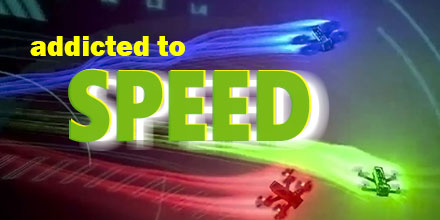
Drones are proving indispensable for a wide variety of applications. From aerial photography and film-making to agriculture and search and rescue operations, drones are now firmly part of the mainstream.
But there's another area where drones are starting to make a huge impact...the racing arena.
Once simply a pastime for RC enthusiasts, drone racing is quickly emerging as a sport widely regarded as the "next big thing".
And, why not? Drone racing features all the elements associated with big time racing: exotic locations, skilled pilots, high speeds, iconic courses, and, of course, wrecks. Plus, it now features all the other elements of organized leagues: television contracts, financial backers, big name sponsors, monetary prizes, and recognized racers.
Drone racing has arrived.
Drone Racing League
In early 2015, the Drone Racing League (DRL) was founded and held its first race at Miami Sunlife Stadium. The league gained early success by securing serious backing from the likes of Miami Dolphins' owner Stephen Ross.
The DRL season consists of races held at iconic locations throughout the world where pilots compete for season points. Those with the highest point totals qualify for the World Championship race, where the winner takes all.
After a successful 2016 season, major sponsors such as German Financial services company Allianz joined as official sponsors.
Rise of Spectator Sports
The DRL involves skilled pilots flying souped-up quadcopters around specially designed three-dimensional courses at high speed. Part of the thrill of drone racing is the First Person View (FPV) viewers experience. Pilots control their drones by wearing special goggles that use the UAVs on-board cameras to relay FPV of the race.
Though DRL is the most recognized, it is not the only official drone racing association. In fact, many start-ups are hard at work to try and stake their spot in the emerging spectator market.
Similar to the unexpected success and growth achieved by competitive gaming (think, EA Sports), drone racing is another spectator sport that many would not have considered a sport not so long ago. EA Sports' events now regularly fill arenas and attract millions more viewers online. Drone racing seeks similar success.
Capturing a Growing Fan Base
While many enthusiasts around the world are starting to take notice of drone racing, nowhere is the sport already as popular as it is in the United States.
Since its founding a little over 2 years ago, Drone Racing League raised over $12 million in finance and signed TV deals with major partners such as ESPN, Sky Sports, and MGM. These TV deals mean gaining access to a much bigger audience, further increasing the mainstream profile of the sport.
Likewise, the US National Drone Racing Championship was created to foster the growth of the sport and its Drone Nationals event is also broadcast on ESPN. The Drone Nationals not only attract pro pilots but also UAV enthusiasts and students looking to grab their opportunity at a big cash prize or at the very least, their own 15 minutes of fame on national sports channels.
DR1 is another drone racing league that pits professional pilots against each other in a variety of locations. DR1 races air on the Discovery Channel, Eurosport, and popular video games streaming website Twitch.
Aside from mainstream TV coverage, drone racing has benefited from social media, which provides ease of access to race footage on sites such as YouTube.
The Future of Drone Racing
To a large extent, the future of drone racing depends on spectator engagement. These high speed races coupled with complex courses can be hard to follow. The FPV perspective certainly helps viewers with an immersive experience. As with other fast-paced sports, replays of action shots, crashes and pilot reactions creates also goes a long way.
The maneuvers and skill showcased by the pilots are part of what draws spectators to the sport, plus, the inevitable crashes. It is this spectacle, alongside drone technology’s rise in prominence, that will continue to fuel the sports popularity.
Although there is a broad range of drone racing organizations already out there, no one league has emerged as the main governing body. Rival leagues continue to work on rules, venues and increasing the number of spectators. Whether one organization emerges as the leading body or not, it’s clear that drone racing is here to stay.
 Drones are proving indispensable for a wide variety of applications. From aerial photography and film-making to agriculture and search and rescue operations, drones are now firmly part of the mainstream.
But there's another area where drones are starting to make a huge impact...the racing arena.
Once simply a pastime for RC enthusiasts, drone racing is quickly emerging as a sport widely regarded as the "next big thing".
And, why not? Drone racing features all the elements associated with big time racing: exotic locations, skilled pilots, high speeds, iconic courses, and, of course, wrecks. Plus, it now features all the other elements of organized leagues: television contracts, financial backers, big name sponsors, monetary prizes, and recognized racers.
Drone racing has arrived.
Drones are proving indispensable for a wide variety of applications. From aerial photography and film-making to agriculture and search and rescue operations, drones are now firmly part of the mainstream.
But there's another area where drones are starting to make a huge impact...the racing arena.
Once simply a pastime for RC enthusiasts, drone racing is quickly emerging as a sport widely regarded as the "next big thing".
And, why not? Drone racing features all the elements associated with big time racing: exotic locations, skilled pilots, high speeds, iconic courses, and, of course, wrecks. Plus, it now features all the other elements of organized leagues: television contracts, financial backers, big name sponsors, monetary prizes, and recognized racers.
Drone racing has arrived.

